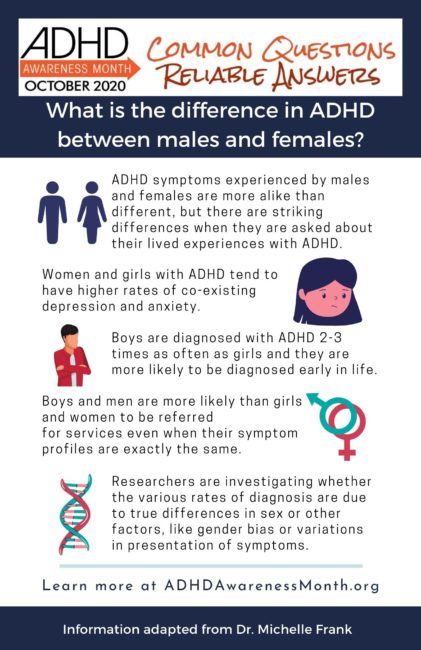When male and female accounts of specific ADHD symptoms are studied, research has found that the symptoms they experience are more alike than different. When you ask women and men about their lived experiences with ADHD, however, you are likely to find some striking differences.
Certain aspects of ADHD – such as rates of diagnosis and treatment, presentation or “type,” and rates of co-existing depression, anxiety, and behavioral disorders – seem to diverge along gender lines in ways similar to other psychiatric diagnoses. Although, again, the reasons behind these differences are layered and confusing. For instance, women and girls with ADHD tend to have a higher incidence of depression and anxiety. This could, in part, be due to a tendency of girls and women to exhibit internalizing behavior (anxiety, depression, people pleasing) while boys and men in general are more likely to display externalizing behaviors (hyperactivity, disruptive behaviors). There has yet to be an agreed upon reason for this difference in the ADHD community, with some trying to identify neurological reasons by looking at the increased rates of inattentive symptoms for females and hyperactive symptoms of males (nature) and others pointing to the complexities of socialization and gender-based behavioral expectations (nurture). (Yes, that same old debate is alive and well!)
Similarly, and likely for a variety of reasons, boys are diagnosed with ADHD two to three times as often as girls and they are more likely to be diagnosed early in life. Researchers are currently investigating whether there is a true difference in incidence of the condition between males and females, or whether differences in rates of diagnoses are due to other factors such as gender bias or variations in presentation of symptoms. Overall, however, women and girls are less likely to be properly diagnosed with ADHD, with boys and men being more likely than girls and women to be referred for services even when their symptom profiles are exactly the same.
Further, a number of complex and nuanced factors influence the female experience of ADHD in ways that continue to lack robust research. One example is the impact of estrogen on dopamine, the brain chemical most prominently implicated in ADHD. Fluctuating estrogen levels can impact the intensity and presentation of ADHD symptoms. Women also continue to face gender-role expectations that do not always align favorably with the strengths and challenges of an ADHD brain. They also have higher rates of self-harming behaviors and lower self-esteem than men with ADHD. For all individuals regardless of gender-identity, it is likely that gendered expectations of behavior might complicate how symptoms are perceived.
While it is important to continue to consider the impact of sex differences on ADHD presentation and experience, it is also pivotal that we begin to question the role that gender-based biases and expectations might play in coloring our perception of the strengths and challenges inherent in this condition. To date, the field lacks meaningful research on the experiences of people with ADHD who do not identify as cis-gender. We all need to be part of the collective story because the more diversity of representation in the research and literature, the more accurately we can diagnose and treat ADHD to help people live well with their differences, not simply in spite of them.
About the Author

Dr. Michelle Frank is a well-regarded specialist in the diagnosis and treatment of ADHD who aims to help her clients learn how to live successfully with ADHD – and without shame. Dr. Frank is the co-author of A Radical Guide for Women with ADHD: Embrace Neurodiversity, Love Boldly, and Break Through Barriers, written in collaboration with Sari Solden and published by New Harbinger. Dr. Frank is committed to ADHD advocacy and awareness campaigns, speaking nationally on issues related to ADHD, women’s empowerment, and neurodiversity.
Further reading
- Mowlem, F.D., Rosenqvist, M.A., Martin, J. et al. Sex differences in predicting ADHD clinical diagnosis and pharmacological treatment. Eur Child Adolesc Psychiatry 28, 481–489 (2019). https://doi.org/10.1007/s00787-018-1211-3
- Hinshaw SP, Owens EB, Zalecki C, et al. Prospective follow-up of girls with attention-deficit/hyperactivity disorder into early adulthood: continuing impairment includes elevated risk for suicide attempts and self-injury. J
- Consult Clin Psychol. 2012;80(6):1041-1051. https://www.ncbi.nlm.nih.gov/pmc/articles/PMC3543865/ Quinn PO, Madhoo M. A review of attention-deficit/hyperactivity disorder in women and girls: uncovering this hidden diagnosis. Prim Care Companion CNS Disord. 2014;16(3):PCC.13r01596. https://www.ncbi.nlm.nih.gov/pmc/articles/PMC4195638/

